Integrating Health and Smartness—New Sustainable Paradigms for the Urban Environment: A Case Study in Lianshi Town (China)
Abstract
1. Introduction
2. Healthy and Smart Cities: A Comparison
- Primary health care: implementing the WHO Health for All [42] strategy to prioritize essential healthcare services accessible to all community members;
- Health promotion: encouraging proactive measures to improve health and prevent illnesses;
- Ottawa Charter (1986): embracing the idea of health as a continuous process and recognizing the need for new skills, processes, styles, and governance structures;
- Health beyond the absence of disease: viewing health holistically, considering physical, mental, and social dimensions;
- Agenda 21: aligning with the principles of sustainable development and addressing environmental and social factors affecting health.
3. Materials and Methods
3.1. Lianshi Case Study
3.2. Brief Historical Background
3.3. The Optimal Strategy for Regeneration: Health and Smartness Combined
- Reactivation by renovating the existing facilities (like maintaining the initial on-site activity with possible technological upgrades towards the so-called green economy);
- Abandonment, with or without protection measures;
- Structural reconversion (keeping an industrial profile with a rearrangement of the buildings);
- Functional and/or structural reconversion (change in function, with or without physical and historic preservation, and reuse linked to typically urban functions but providing urban systems with a high incidence of public services and equipment to significantly improve urban quality).
- Green and leisure spaces: ample parks and recreational areas promoting physical activity and mental well-being;
- Clean environment: effective waste management, air quality control, and pollution reduction measures;
- Safe infrastructure: secure public spaces, well-lit streets, and efficient emergency services;
- Healthy lifestyle promotion: community programs promoting healthy habits, nutrition, and fitness;
- Social inclusion: places and facilities to ensure the well-being of diverse populations;
- Active transportation: infrastructure network supporting walking, cycling, and other forms of eco-friendly transportation.
- Integrated mobility: intelligent transportation systems for traffic management and improved public transit;
- Sustainable energy: integration of renewable energy sources and smart energy management;
- Connected infrastructure: interconnected devices and systems for efficient resource utilization;
- Smart buildings: intelligent construction and management systems for energy efficiency and occupant comfort;
- Digital inclusion: ensuring access to technology and digital services for all residents;
- Innovation ecosystem: support for technology-driven innovation and entrepreneurship.
3.4. From Architectural Competition to Execution: Enhancing Lianshi’s Regeneration
4. Results and Discussion
- Public recreation areas: Transforming vacant spaces between buildings into various public recreation areas that promote an active lifestyle and encourage social interaction. These recreation areas can contribute to the physical and mental well-being of the community, providing open spaces for outdoor activities.
- Social aggregation: Designed elements along internal paths that encourage social aggregation are crucial for promoting mental health and a sense of community. Evoking collective memories through these features strengthens bonds among residents and create a more cohesive social fabric.
- Green spaces and connectivity: Creating new pathways and open green spaces enhances connectivity and promotes a healthy lifestyle. These elements can encourage walking and physical activity, contributing to a more active and sustainable community.
- Community Condenser: The ‘Community Condenser’ concept as a social catalyst is a smart element. Using local history and existing structures as a cultural motivator demonstrates a smart approach to urban planning, leveraging heritage to drive sustainable urban development.
- Heritage Revitalization: The approach of transforming the entire area along the canal into a historic district while preserving distinctive features reflects a savvy integration of the past into the present. This demonstrates how history can be key in creating modern and dynamic urban environments.
- Connectivity and ICT hubs: The development of new pathways and the presence of ICT hubs indicate a smart approach to connectivity and technology. Improving circulation through specific signage and open spaces suggests a smart infrastructure that facilitates movement and access to digital resources.
- Emphasis on fostering innovation and building healthy environments.
- Focus on addressing residents’ daily needs and proposing ‘community commerce’ as a primary function.
- Strategic combination of demolition, restoration, and renovation to eliminate congestion and create continuous, accessible spaces.
- Preservation action to give value to structures with historical significance, contributing to heritage conservation.
- Consideration of the significance of sustainability for both innovation-driven urban development and heritage conservation.
- Utilization of local knowledge and understanding of residents’ needs as part of the ‘proximity principle’.
- Implementation of a renovation masterplan that involves activating street corners and readjusting the scale of empty squares, contributing to a smarter urban layout.
- Promotion of the concept of ‘creating local future scenarios’ through innovative, community-oriented solutions.
- Integration of non-standard commercial projects centered around the concept of ‘locality’ aligns with the smart city approach.
5. Conclusions
Author Contributions
Funding
Data Availability Statement
Acknowledgments
Conflicts of Interest
References
- Gandy, M. Concrete and Clay: Reworking Nature in New York City; MIT Press: Cambridge, MA, USA, 2002. [Google Scholar]
- Houston, D.; Hillier, J.; MacCallum, D.; Steele, W.; Byrne, J. Make kin, not cities! Multispecies entanglements and ‘becoming-world’ in planning theory. Plan. Theory 2018, 17, 190–212. [Google Scholar] [CrossRef]
- Whatmore, S. Hybrid Geographies: Natures Cultures Spaces; SAGE Publications: New York, NY, USA, 2002. [Google Scholar]
- Wolch, J. Zoöpolis. Capital. Nat. Social. 1996, 7, 21–47. [Google Scholar] [CrossRef]
- Pietra, C. Healthy City: An Ontological Understanding. Ph.D. Thesis, Università Degli Studi di Pavia, Pavia, Italy, 30 May 2022. [Google Scholar]
- Portugali, J. Complex Artificial Environments. Simulation, Cognition and VR in the Study and Planning of Cities; Springer: Berlin/Heidelberg, Germany, 2006. [Google Scholar]
- Berman, L.; Morar, C.; DeGrane, L.; Unkart, S.; Erdal, S. Brownfields in Romania and the United States: A Visual Tour. J. Environ. Health 2022, 85, 28–38. [Google Scholar]
- Lawless, P. Britain’s Inner Cities; Paul Chapman Publishing Ltd.: London, UK, 1989; pp. 23–40. [Google Scholar]
- Couch, C.; Fraser, C.; Percy, S. Urban Regeneration in Europe; Blackwell Publishing: Oxford, UK, 2003; pp. 12–14. [Google Scholar]
- Marlijn, B.; Smit, M.; Dewulf, G. Planning and commitment in cultural heritage projects. J. Cult. Herit. Manag. Sust. Dev. 2013, 3, 163–174. [Google Scholar] [CrossRef]
- Ibrahim, H.; Al-Hagla, K.; Nassar, D. Towards a sustainable city: Brownfields as a potential for urban development. J. Eng. Appl. Sci. 2020, 67, 1903–1922. [Google Scholar]
- Cao, K.; Guan, H. Brownfield redevelopment toward sustainable urban land use in China. Chin. Geogr. Sci. 2007, 17, 127–134. [Google Scholar] [CrossRef]
- Sun, Y.; Li, H.; Lei, S.; Semple, K.T.; Coulon, F.; Hu, Q.; Gao, J.; Guo, G.; Gu, Q.; Jones, K.C. Redevelopment of urban brownfield sites in China: Motivation, history, policies and improved management. Eco-Environ. Health 2022, 1, 63–72. [Google Scholar] [CrossRef]
- Alker, S.; Joy, V.; Roberts, P.; Smith, N. The definition of brownfield. J. Environ. Plan. Manag. 2000, 43, 49–69. [Google Scholar] [CrossRef]
- Niu, H. Renovation and redevelopment of brownfield in the United States. Int. Urban Plan. 2001, 30, 26–48. [Google Scholar]
- Li, X.; Li, F. Overview of the Current Situation on Brownfield Remediation and Redevelopment in China, Sustainable Development—East Asia and Pacific Region Discussion Papers; World Bank: Washington, DC, USA, 2010. [Google Scholar]
- Eurostat Statistics Explained. Urban-Rural Europe—Introduction. Available online: https://ec.europa.eu/eurostat/statistics-explained/index.php?title=Main_Page (accessed on 13 March 2024).
- Morar, C.; Berman, L.; Unkart, S.; Erdal, S. Sustainable brownfields redevelopment in the European Union: An overview of policy and funding frameworks. J. Environ. Health 2021, 84, 24. [Google Scholar] [PubMed]
- GRNUHE. Improving Urban Health Equity through Action on the Social and Environmental Determinants of Health: Global Research Network on Urban Health Equity; UCL: London, UK, 2010. [Google Scholar]
- Hancock, T. Health, human development and the community ecosystem: Three ecological models. Health Promo. Int. 1993, 8, 41–47. [Google Scholar] [CrossRef]
- Act Locally: Community-Based Population Health Promotion. Appendix B. A Report for The Senate Sub-Committee on Population Health. Available online: http://www.parl.gc.ca/Content/SEN/Committee/402/popu/rep/appendixBjun09-e.pdf (accessed on 28 December 2023).
- Kickbusch, I. Triggering Debate, White Paper: The Food System—A Prism of Present and Future Challenges for Health Promotion and Sustainable Development; Health Promo.: Bern, Switzerland, 2010. [Google Scholar]
- Law, S.H.; Bany-Ariffin, A.N. Institutional Infrastructure and Economic Performance: Dynamic Panel Data Evidence. Transit. Stud. Rev. 2008, 15, 542–557. [Google Scholar] [CrossRef]
- Zheng, W.; Shen, G.Q.; Wang, H.; Hong, J.; Li, Z. Decision support for sustainable urban renewal: A multi-scale model. Land Use Policy 2017, 69, 361–371. [Google Scholar] [CrossRef]
- World Health Organization. Shanghai Declaration on Promoting Health in the 2030 Agenda for Sustainable Development. WHO 9th Global Conference on Health Promotion. November 2016. Available online: https://www.who.int/publications/i/item/WHO-NMH-PND-17.5 (accessed on 28 December 2023).
- Barton, H.; Grant, M. Urban planning for healthy cities: A review of the progress of the European healthy cities program. J. Urban Health 2011, 90, 129–141. [Google Scholar] [CrossRef]
- Goodspeed, R. Smart cities: Moving beyond urban cybernetics to tackle wicked problems. Camb. J. Reg. Econ. Soc. 2015, 8, 79–92. [Google Scholar] [CrossRef]
- Greenfield, A. Against the Smart City (The City Is Here for You to Use Book 1); Do Projects: New York, NY, USA, 2013. [Google Scholar]
- Townsend, A. Smart Cities: Big Data, Civic Hackers, and the Quest for a New Utopia; W W Norton: New York, NY, USA, 2013. [Google Scholar]
- OECD. Smart Cities and Inclusive Growth: Building on the Outcomes of the 1st OECD Roundtable on Smart Cities and Inclusive Growth. 2020. Available online: http://www.oecd.org/cfe/cities/OECD_Policy_Paper_Smart_Cities_and_Inclusive_Growth.pdf (accessed on 5 January 2024).
- Łukaszkiewicz, J.; Fortuna-Antoszkiewicz, B.; Oleszczuk, Ł.; Fialová, J. The Potential of Tram Networks in the Revitalization of the Warsaw Landscape. Land 2021, 10, 375. [Google Scholar] [CrossRef]
- Batty, M.; Marshall, S. The evolution of cities: Geddes, Abercrombie and the New physicalism. Town Plan. Rev. 2009, 80, 551–574. [Google Scholar] [CrossRef]
- Batty, M.; Marshall, S. Complexity theories of cities: Achievements, cristicism and potentials. In Complexity Theories of Cities Have Come of Age. An Overview with Implications to Urban Planning and Design; Portugali, J., Meyer, H., Stolk, E., Tan, E., Eds.; Springer: Berlin, Germany, 2012. [Google Scholar]
- Morris, G.P.; Reis, S.; Beck, S.A.; Fleming, L.E.; Adger, W.N.; Benton, T.G.; Depledge, M.H. Scoping the proximal and distal dimensions of climate change on health and well-being. Environ. Health 2017, 16, 116. [Google Scholar] [CrossRef]
- Acuto, M.; Parnell, S.; Seto, K.C. Building a global urban science. Nat. Sustain. 2018, 1, 2–4. [Google Scholar] [CrossRef]
- Canadian Public Health Association; Beyond Health Care. Proceedings of a working conference on Healthy public policy. Can. J. Public Health 1985, 76 (Suppl. S1), 1–104. [Google Scholar]
- European Commission. Smart Cities. N.D. Available online: https://ec.europa.eu/info/eu-regional-and-urban-development/topics/cities-and-urban-development/city-initiatives/smart-cities_en (accessed on 5 January 2024).
- Ristvej, J.; Lacinák, M.; Ondrejka, R. On Smart City and Safe City Concepts. Mob. Netw. Appl. 2020, 25, 836–845. [Google Scholar] [CrossRef]
- Pietra, C.; De Lotto, R.; Bahshwan, R. Approaching Healthy City Ontology: First-Level Classes Definition Using BFO. Sustainability 2021, 13, 13844. [Google Scholar] [CrossRef]
- Mosannenzadeh, F.; Vettorato, D. Defining Smart City. A Conceptual Framework Based on Keyword Analysis. In Proceedings of the 8th International Conference—INPUT 2014, Naples, Italy, 4–6 June 2014. [Google Scholar]
- Nutbeam, D.; Kickbusch, I. Health promotion glossary. Health Promot. Int. 1998, 13, 349–364. [Google Scholar] [CrossRef]
- World Health Organization. Global Strategy for Health for All by the Year 2000; World Health Organization: Geneva, Switzerland, 1981. [Google Scholar]
- Kickbush, I. Healthy Cities: A working project and a growing movement. Health Promot. Int. 1989, 4, 77–82. [Google Scholar] [CrossRef]
- Kenzer, M. Healthy Cities: A guide to the literature. Public Health Rep. 2000, 115, 279–289. [Google Scholar] [CrossRef]
- van Naerssen, T.; Barten, F. Healthy Cities as a political process. In Healthy Cities in Developing Countries: Lessons to Be Learned; Naerssen, T., Barten, F., Eds.; Verlag fur Entwicklungspolitik Saarbrucken GmbH: Saarbrucken, Germany, 2002; pp. 1–23. [Google Scholar]
- Duhl, L. Healthy Cities and the Built Environment. Built Environ. 2005, 31, 356–361. [Google Scholar] [CrossRef]
- Dameri, R.P. Searching for Smart City definition: A comprehensive proposal. Int. J. Comput. Technol. 2013, 11, 2544–2551. [Google Scholar] [CrossRef]
- Goumans, M.; Springett, J. From projects to policy: ‘Healthy cities’ as a mechanism for policy change for health? Health Promot. Int. 1997, 12, 311–322. [Google Scholar] [CrossRef]
- Werna, E.; Trudy, H. The evaluation of Healthy City projects in developing countries. Habitat Int. 1995, 19, 629–641. [Google Scholar] [CrossRef]
- Bern, A. Architecture competitions in an urban planning context. J. Urban Des. 2017, 23, 239–256. [Google Scholar] [CrossRef]
- Davison, G.; Freestone, R.; Hu, R.; Backer, S. The impacts of mandatory design competitions on urban design quality in Sydney, Australia. J. Urban Des. 2018, 23, 257–277. [Google Scholar] [CrossRef]
- Garde, A. Citizen participation, design competition and the product in urban design: Insights from the Orange County Great Park. J. Urban Des. 2014, 19, 89–118. [Google Scholar] [CrossRef]
- White, J.T. Pursuing design excellence: Urban design governance on Toronto’s waterfront. Prog. Plan. 2016, 110, 1–41. [Google Scholar] [CrossRef]
- Tang, H.; Jiang, R. Behaviours·Space·Site: Exploration on Transformation of Exterior Space of Granary Groups at Lianshi Town in Huzhou, Zhejiang. China Acad. J. Electron. Publ. House 2022, 168–173. [Google Scholar] [CrossRef]
- Chen, B.; Wu, C. Urban Renewal Practice | Lianshi Cuckoo—Commercial Value Transformation of Industrial Relics in Small Towns (Translated). Available online: https://rb.gy/xyt1p5. (accessed on 15 January 2024).
- Anttiroiko, A.V.; Valkama, P.; Bailey, S. Smart Cities in the New Service Economy: Building Platforms for Smart Services. J. AI Soc. 2013, 28, 1–12. [Google Scholar] [CrossRef]
- Hollands, R.G. Critical interventions into the corporate Smart City. Camb. J. Reg. Econ. Soc. 2014, 8, 61–77. [Google Scholar] [CrossRef]
- Fainstein, S.S. The Changing World Economy and Urban Restructuring, Leadership and Urban Regeneration: Cities in North America and Europe; Judd, D.R., Parkinson, M., Eds.; Sage: London, UK, 1990; pp. 33–35. [Google Scholar]
- Lever, W.F. Deindustrialisation and the Reality of the Postindustrial City. Urban Stud. 1991, 28, 983–999. [Google Scholar] [CrossRef]
- Healey, P. The institutional challenge for sustainable urban regeneration. Cities 1995, 4, 542–547. [Google Scholar] [CrossRef]
- Ginelli, E.; Pozzi, G.; Lazzati, G.; Pirillo, D.; Vignati, G. Regenerative urban space: A box for public space use. Regen. Built Environ. A Circ. Econ. Perspect. 2020, 137–147. [Google Scholar]
- Gavrilidis, A.A.; Ioja, I.C.; Saghin, I. Urban Regeneration through Industrial Restructuring of Brownfields in the Local Economies of Post Communist Countries. Case Study: Romania. In Proceedings of the 47th ISOCARP Congress Liveable Cities: Urbanising World, Meeting the Challenge, Wuhan, China, 25–28 October 2011. [Google Scholar]
- Jiang, P.; Pietra, C.; Shi, B.; Healy, S. Community Condenser—Granary Space Regeneration Design in Lianshi Town. In Proceedings of the UIA2021Rio International Conference, Rio De Janeiro, Brasil, 18–22 July 2021; ACSA Press: New York, NY, USA, 2021; Volume 3, pp. 1407–1408. [Google Scholar]
- World Health Organization. Healthy Cities. Promoting Health and Equity—Evidence for Local Policy and Practice. Summary Evaluation of Phase V of WHO European Healthy Cities Network. Available online: www.euro.who.int (accessed on 28 December 2023).
- Anthopoulos, L.G. Understanding the Smart City Domain: A Literature Review. In Transforming City Governments for Successful Smart Cities; Rodriguez-bolivar, M.P., Ed.; Springer International Publishing: Granada, Spain, 2015. [Google Scholar] [CrossRef]
- Pietra, C.; Venco, E.M. Urban Regeneration for Smart Communities. Applying methods for megalopolis and towns in China. In Planning, Nature and Ecosystem Services. Smart City, Urban Planning for a Sustainable Future; Gargiulo, C., Zoppi, C., Eds.; FedOAPress: Napoli, Italy, 2019; Volume 5, pp. 605–618. [Google Scholar] [CrossRef]
- Gartner. Hype Cycle for Smart City Technologies and Solutions. Available online: https://www.gartner.com/en/ (accessed on 5 January 2024).
- Giovanella, C.; Dascalu, M.; Scaccia, F. Smart City Analytics: State of the art and future Perspectives. Interact. Des. Archit. J. 2014, 20, 72–87. [Google Scholar] [CrossRef]
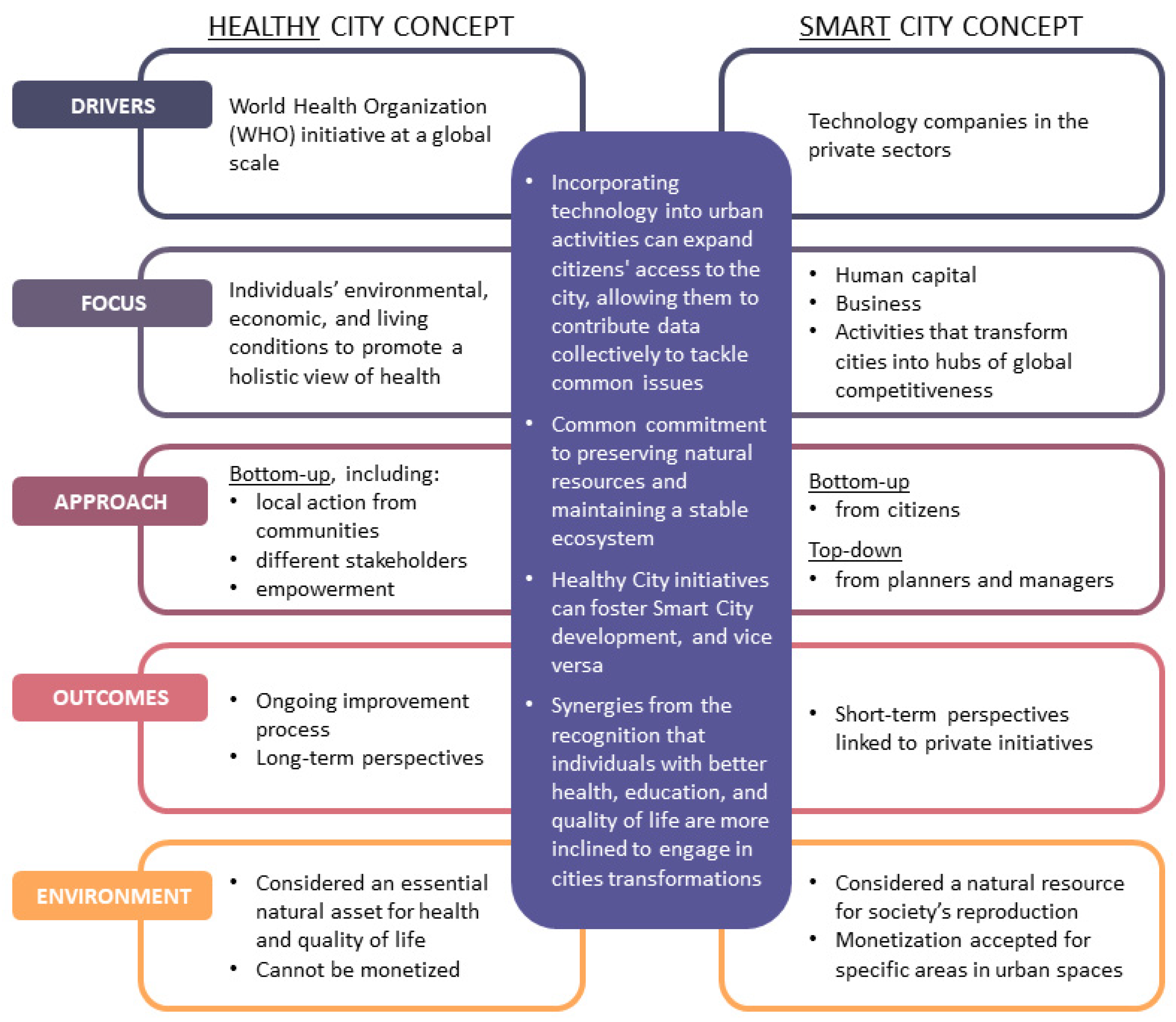
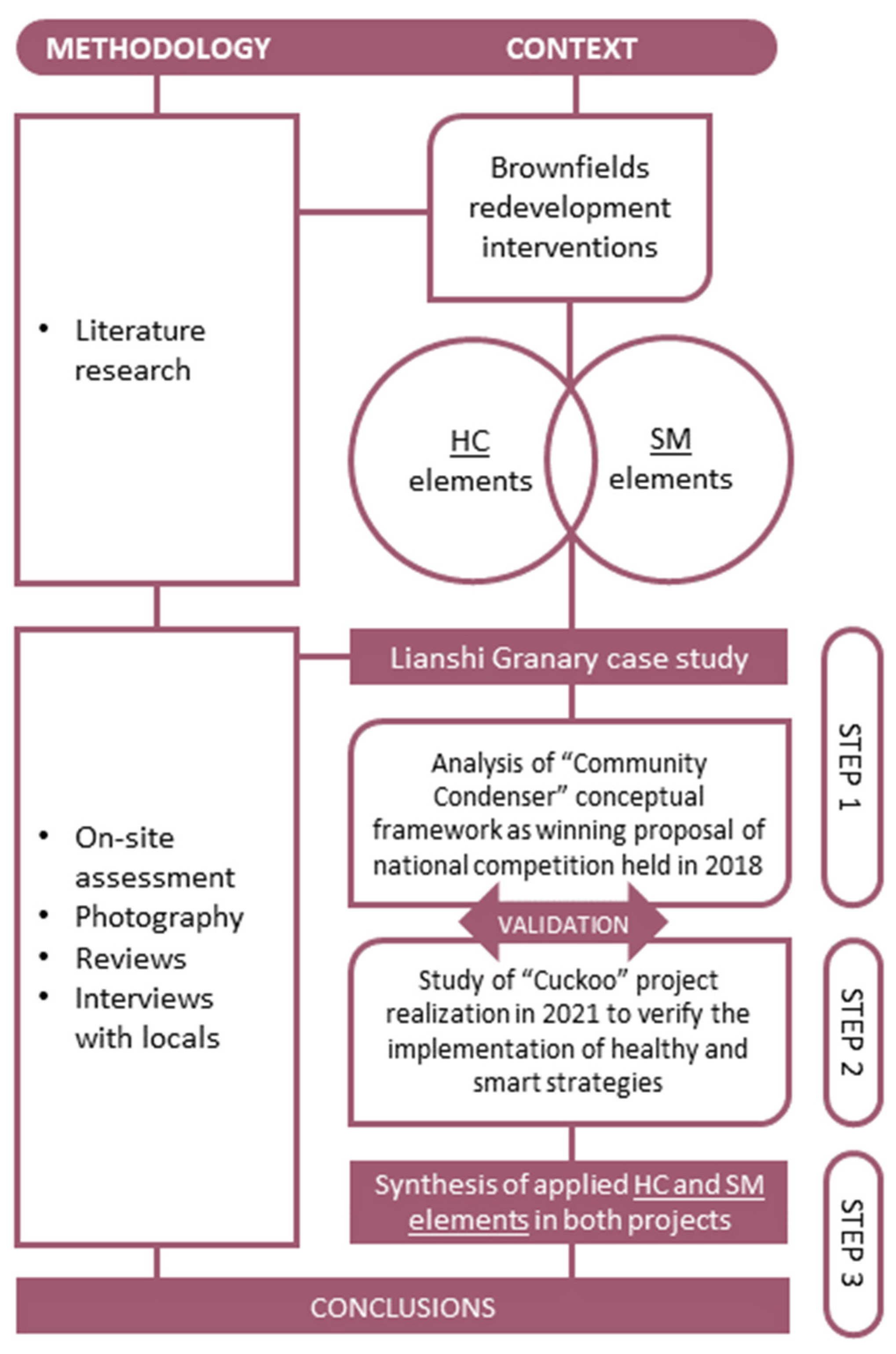

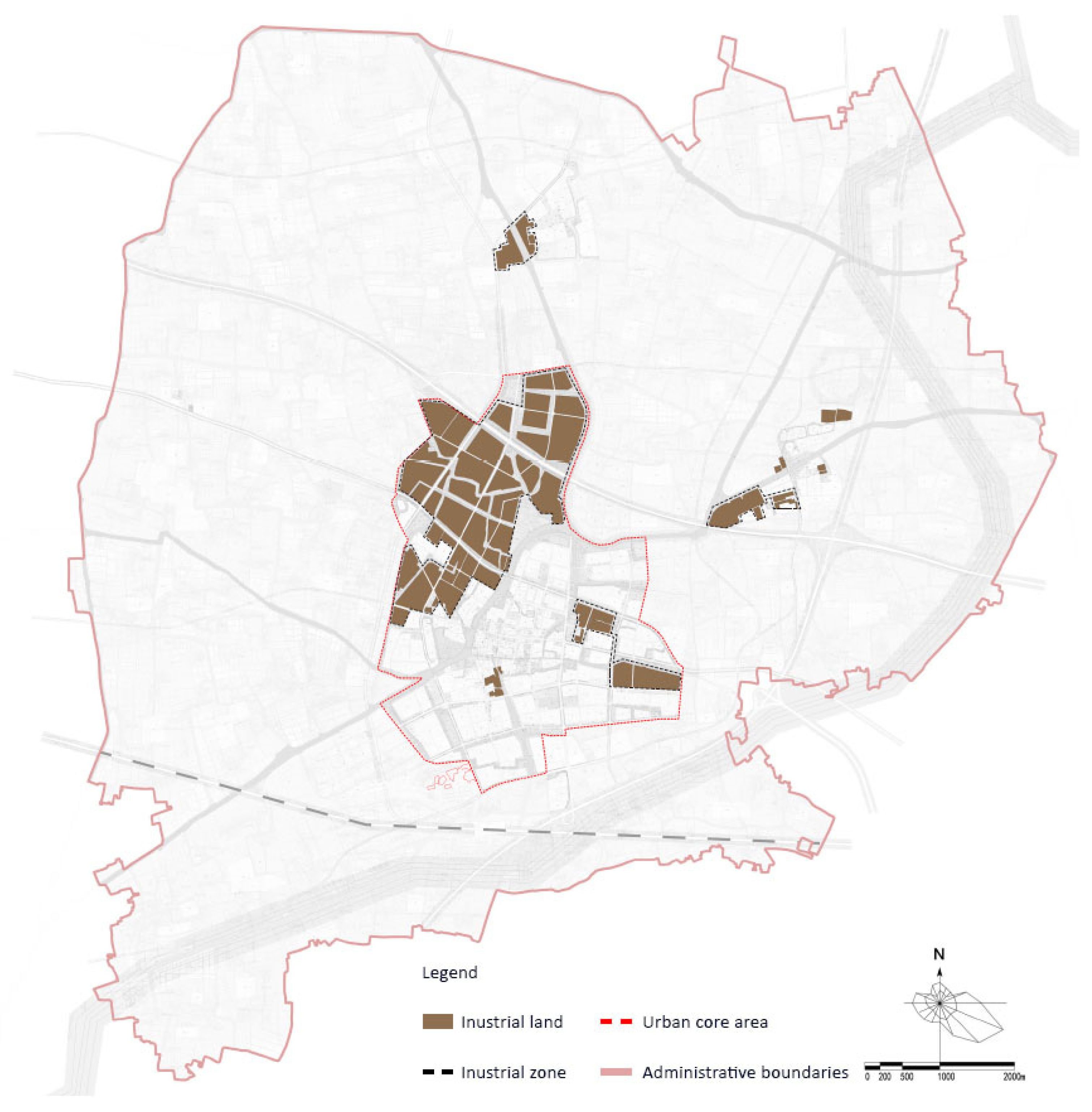
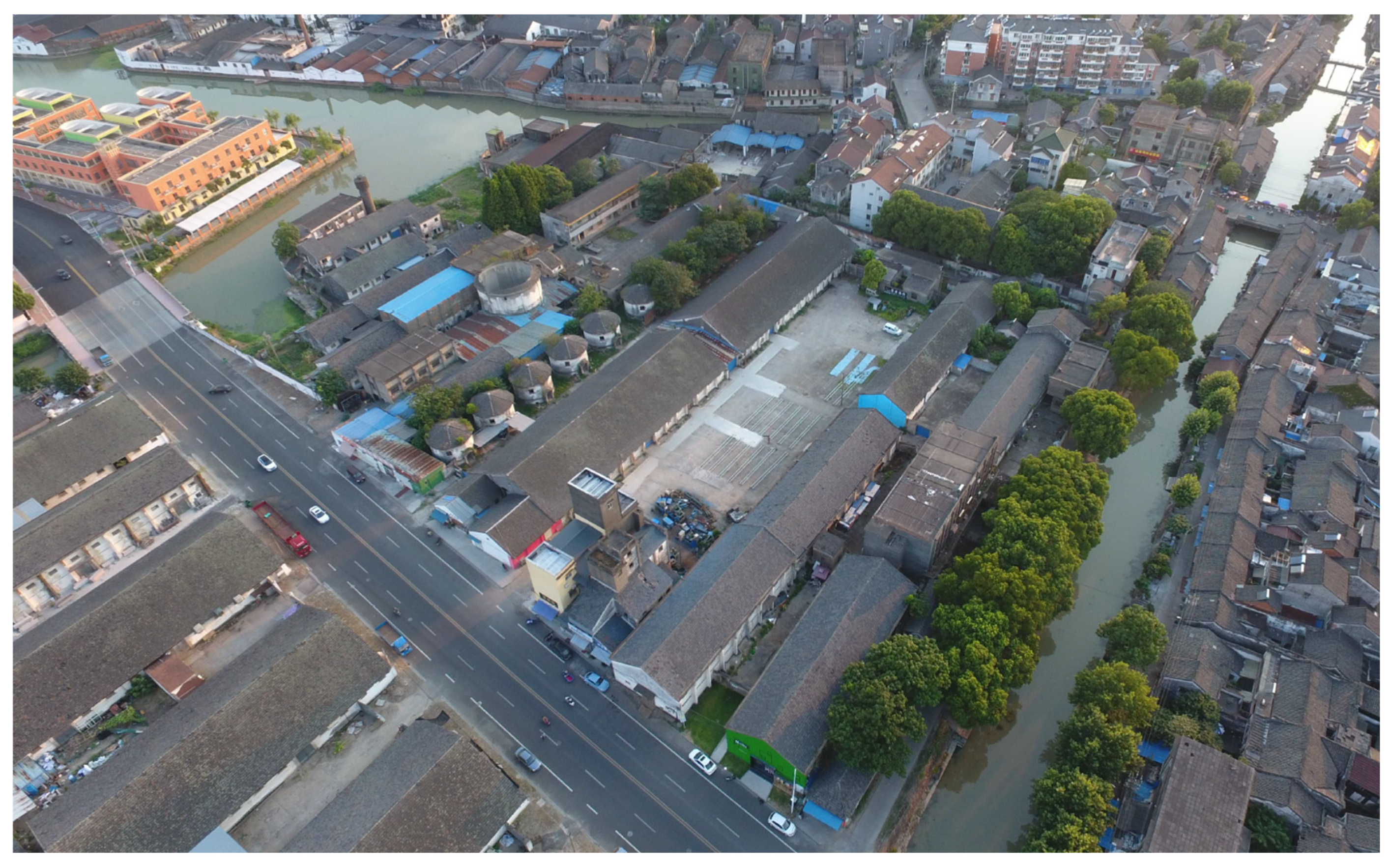
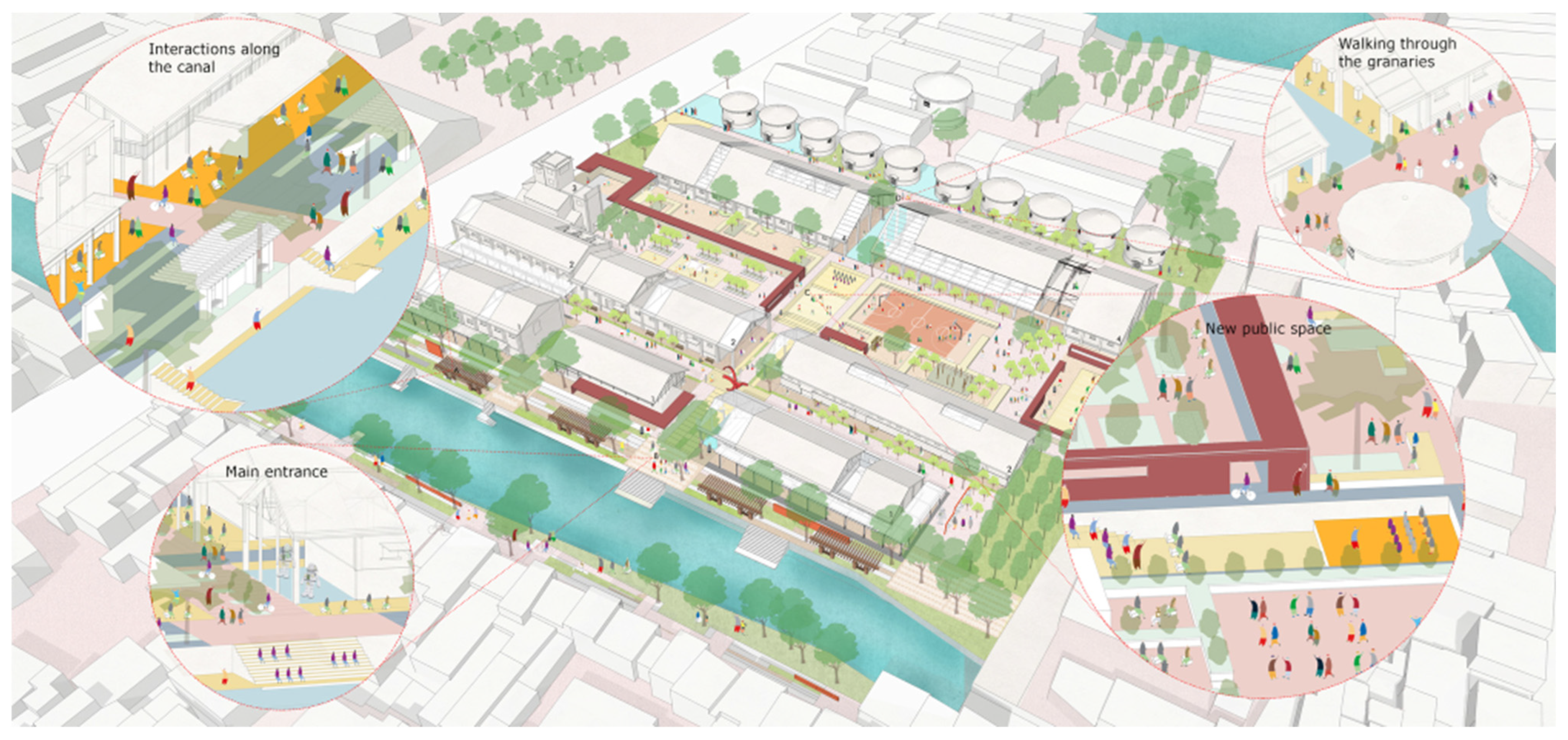
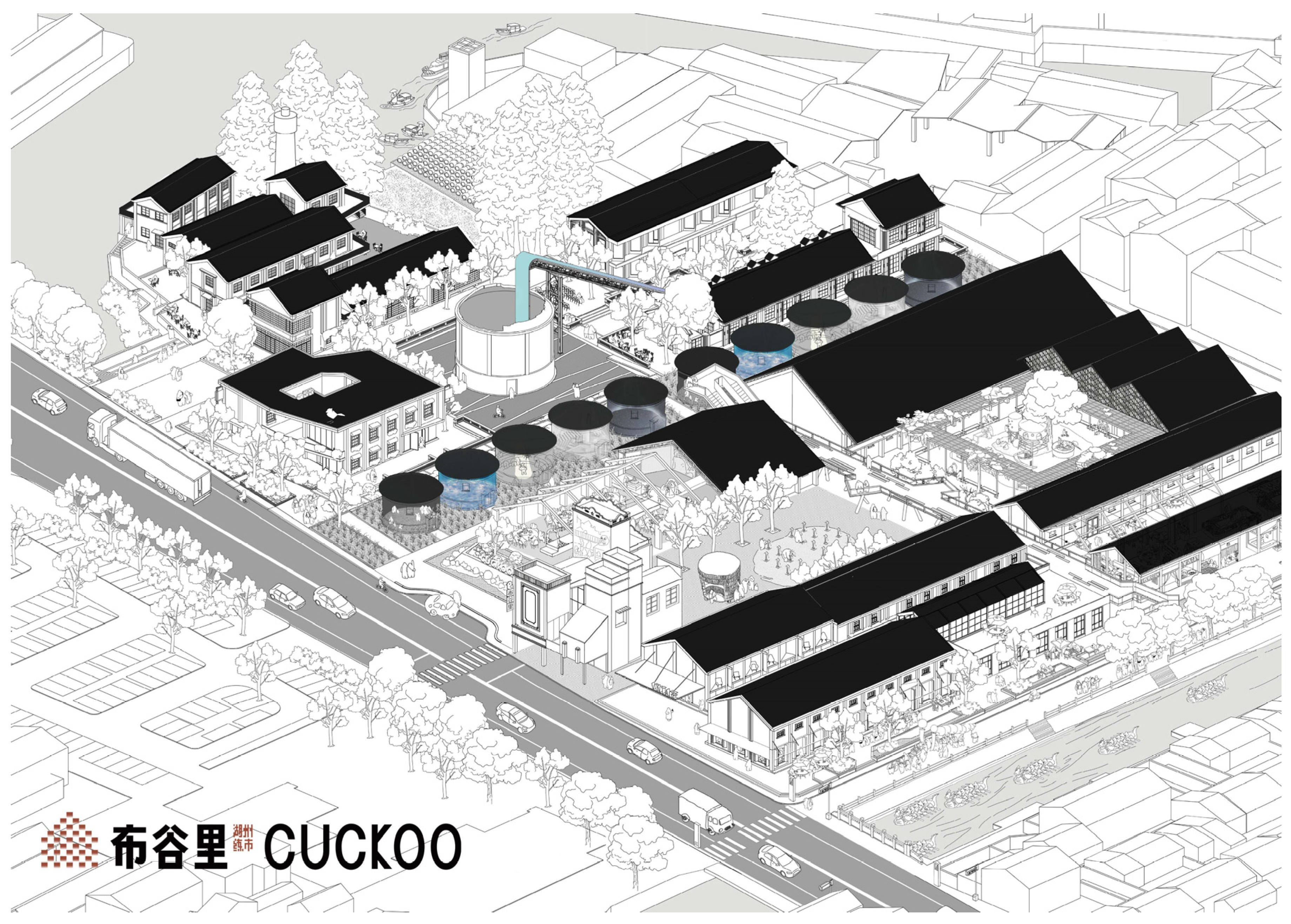
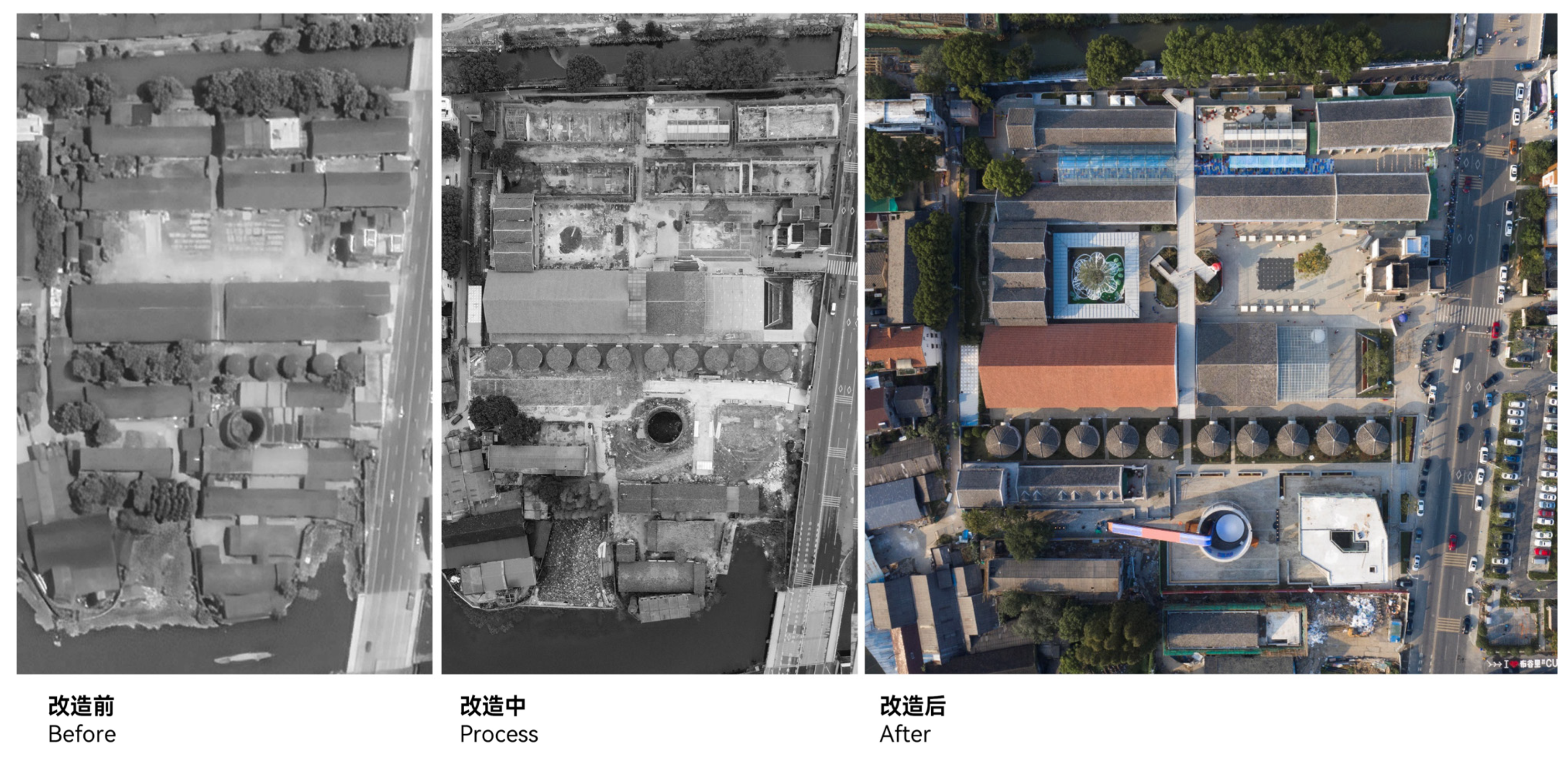
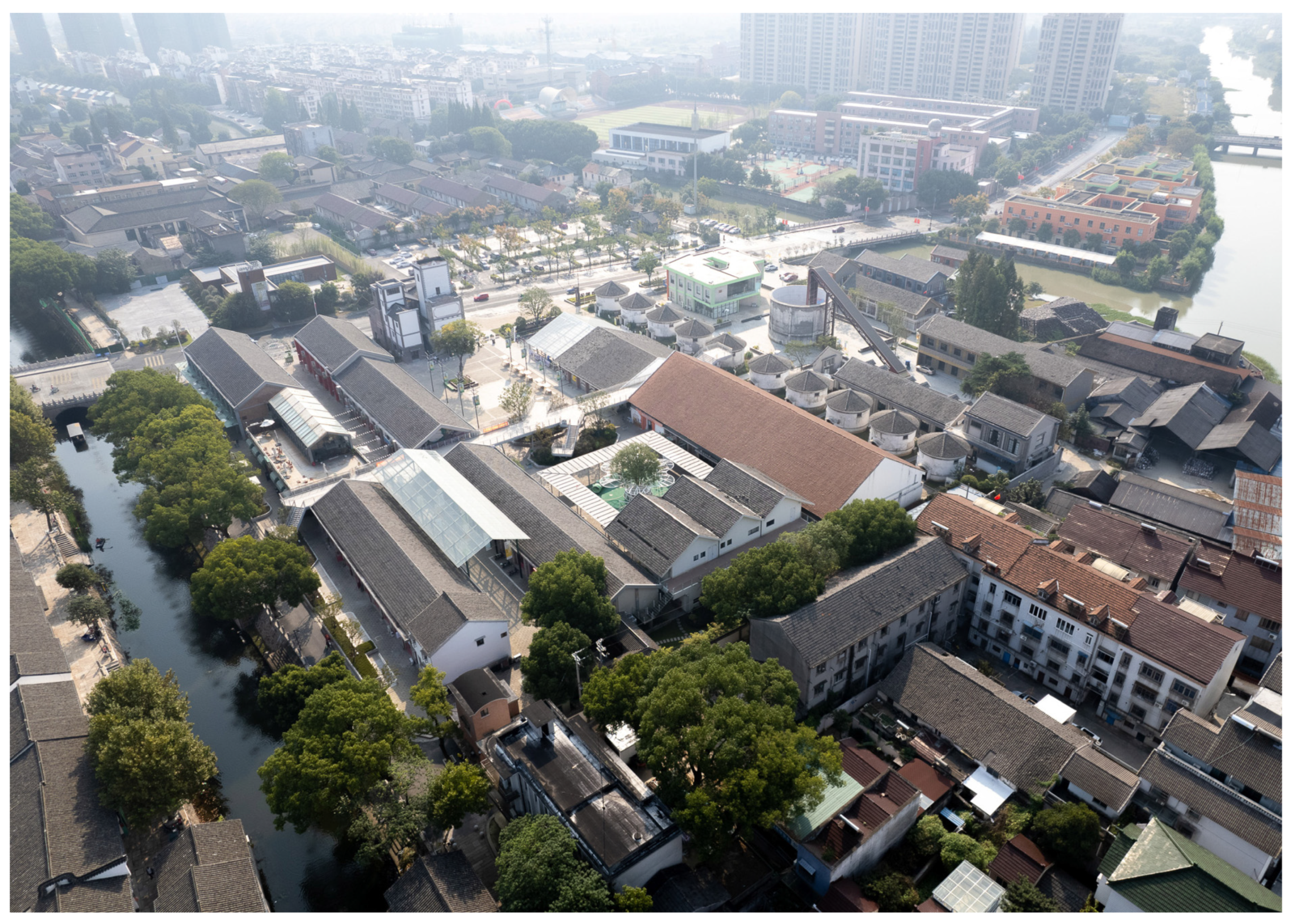
Disclaimer/Publisher’s Note: The statements, opinions and data contained in all publications are solely those of the individual author(s) and contributor(s) and not of MDPI and/or the editor(s). MDPI and/or the editor(s) disclaim responsibility for any injury to people or property resulting from any ideas, methods, instructions or products referred to in the content. |
© 2024 by the authors. Licensee MDPI, Basel, Switzerland. This article is an open access article distributed under the terms and conditions of the Creative Commons Attribution (CC BY) license (https://creativecommons.org/licenses/by/4.0/).
Share and Cite
Pietra, C.; Venco, E.M. Integrating Health and Smartness—New Sustainable Paradigms for the Urban Environment: A Case Study in Lianshi Town (China). Land 2024, 13, 405. https://doi.org/10.3390/land13040405
Pietra C, Venco EM. Integrating Health and Smartness—New Sustainable Paradigms for the Urban Environment: A Case Study in Lianshi Town (China). Land. 2024; 13(4):405. https://doi.org/10.3390/land13040405
Chicago/Turabian StylePietra, Caterina, and Elisabetta Maria Venco. 2024. "Integrating Health and Smartness—New Sustainable Paradigms for the Urban Environment: A Case Study in Lianshi Town (China)" Land 13, no. 4: 405. https://doi.org/10.3390/land13040405
APA StylePietra, C., & Venco, E. M. (2024). Integrating Health and Smartness—New Sustainable Paradigms for the Urban Environment: A Case Study in Lianshi Town (China). Land, 13(4), 405. https://doi.org/10.3390/land13040405






